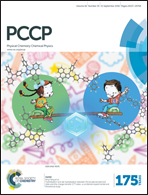Probing protein adsorption on a nanoparticle surface using second harmonic light scattering†
Abstract
A new application of second harmonic light scattering to probe protein physisorption on a gold nanoparticle surface in aqueous buffer is reported. The free energies of adsorption, the number of protein molecules adsorbed on the surface and the binding affinity of a moderate size protein, alcohol dehydrogenase (ADH), and a small protein, insulin, have been determined using the change in the second harmonic scattered light signal as a function of binding. Four different size gold nanoparticles from 15 to 60 nm were used to determine the effect of size on the free energy change, the affinity constant and the number of protein molecules adsorbed on the surface. All were shown to increase with an increase in size. The binding can be reversed by centrifugation, and the protein molecules can be desorbed quantitatively. The application of this method for studying thermodynamic parameters of weakly interacting biomolecules with nanoparticles for nanoparticle based diagnostic and therapeutic formulations is important.


 Please wait while we load your content...
Please wait while we load your content...